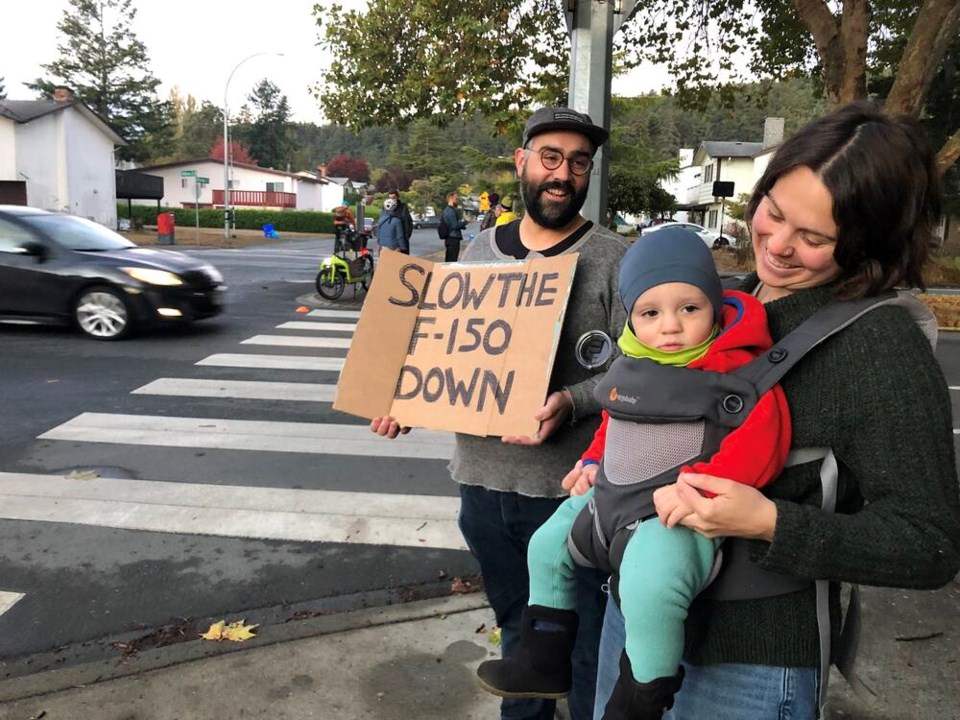My daughter was getting ready for school Tuesday morning when a friend texted her that she was on a bus that was held up in traffic because a vehicle had hit a child. The friend could hear the child screaming in pain. It was a haunting image.
As news got out that yet another child had been hit in a crosswalk — mercifully, this one was not killed or severely injured, like Kaydence Bourque or Leila Bui — someone tweeted that Saanich has to do more to improve the safety of its roads. A lot more, including installing raised crosswalks.
And of course, there was the standard retort: “You can’t fix stupid,” wrote one tweeter. “There will always be irresponsible drivers that cause accidents or pedestrians that run onto the road and get hit. Whenever there is an accident everyone jumps on the fix roads bandwagon.”
Where to begin? No, you can’t fix stupid, as the tweet writer has amply shown.
You can, however, fix roads so fewer people — much fewer people — are killed or maimed.
You can reduce speed limits, so even if there is no enforcement, those who follow the limit slow traffic down, which improves pedestrians’ chances of surviving being hit. You can raise crosswalks so drivers have a physical reminder that soft, squishy humans might also be using the road. You can paint “school zone” in huge letters on the road, for those who somehow didn’t see the signs.
You can narrow areas where humans cross so drivers are forced to go more slowly and pedestrians have less distance to cover.
As a woman who investigated plane crashes for the Transportation Safety Board once told me, humans will always make errors. Systems have to be designed so they don’t turn into tragedies.
There are countless steps you can take to make roads safer for non-metal-encased humans, all of which, if they were employed, would right a balance that has been skewed toward the car for so long that many people — the tweet writer included — think that’s just the natural order of things.
Maybe that’s because in sa国际传媒 and the U.S., relatively fewer people walk than drive — walking, apparently, is for people with dogs and those who can’t afford a car. (Oh, and apparently people who enjoy flinging themselves bodily into traffic to annoy drivers.)
Saanich police’s news release about the child being hit had the usual tiresome list of things pedestrians should be doing to protect themselves: Wear lighter clothing! Make eye contact with drivers!
Where was the list for drivers? Isn’t eye contact a two-way street?
That’s why I was thrilled to see ICBC’s fall pedestrian safety campaign actually shift from the usual laser focus on “what pedestrians can do” to “what drivers AND pedestrians can do.”
Sure it lacks punch, but ICBC’s campaign slogan makes an excellent point: “You see pedestrians when you really look for them.”
Anyone who walks as much as I do has had many near misses, and in virtually every case I’ve experienced, the driver wasn’t looking at all for a pedestrian in the crosswalk. They’re always quite startled to see me standing inches from their vehicle. And that’s in broad daylight and perfect conditions.
Pedestrian fatalities more than double in fall and winter, according to ICBC, which notes that 80% of crashes involving pedestrians happen at intersections, most often from 3 to 6 p.m. on Thursdays and Fridays.
Distracted driving and failing to yield the right-of-way are the top contributing factors.
Did you see “pedestrians flinging themselves into intersections to assert their right of way” on that list of top contributing factors? No, weirdly, I didn’t either. It was all stuff drivers do, or don’t do.
“Drivers should be ready to yield to pedestrians near crosswalks, transit stops and before turning at intersections,” the insurance provider says, adding: “Pedestrians can help stay safe by making eye contact with drivers, using designated crosswalks and watching for vehicles turning at intersections,” before finishing with: “Both drivers and pedestrians should always avoid distractions and take extra time to scan their surroundings.”
A nice, well-rounded approach to a problem for which pedestrians have been shouldering the responsibility — and the blame — for too long.
The other day, I was sitting on my bike waiting to go straight when a driver to my left leaned toward the passenger side of her vehicle and started waving frantically at me.
At first I thought I must know her, then I realized she was doing exactly the right thing: She was making sure I was aware that she was turning right, in front of me.
Bravo. More drivers should be like her, and start really looking for people they have the power to kill or maim.
No one wants to be the cause of someone screaming in pain, especially a child.



